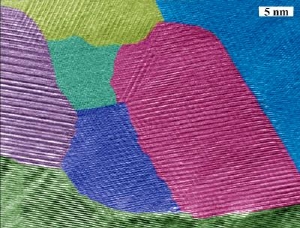Mar 20 2008
Researchers at Boston College and MIT have used nanotechnology to achieve a major increase in thermoelectric efficiency, a milestone that paves the way for a new generation of products - from semiconductors and air conditioners to car exhaust systems and solar power technology - that run cleaner.
 A cross-section of nano-crystalline bismuth antimony telluride grains, as viewed through transmission electron microscope. Colors highlight the features of each grain of the semiconductor alloy in bulk form. A team of researchers from Boston College and MIT produced a major increase in thermoelectric efficiency after using nanotechnology to structure the material, which is commonly used in industry and research.
A cross-section of nano-crystalline bismuth antimony telluride grains, as viewed through transmission electron microscope. Colors highlight the features of each grain of the semiconductor alloy in bulk form. A team of researchers from Boston College and MIT produced a major increase in thermoelectric efficiency after using nanotechnology to structure the material, which is commonly used in industry and research.
The team’s low-cost approach, details of which are published today in the online version of the journal Science, involves building tiny alloy nanostructures that can serve as micro-coolers and power generators. The researchers said that in addition to being inexpensive, their method will likely result in practical, near-term enhancements to make products consume less energy or capture energy that would otherwise be wasted.
The findings represent a key milestone in the quest to harness the thermoelectric effect, which has both enticed and frustrated scientists since its discovery in the early 19th century. The effect refers to certain materials that can convert heat into electricity and vice versa. But there has been a hitch in trying to exploit the effect: most materials that conduct electricity also conduct heat, so their temperature equalizes quickly. In order to improve efficiency, scientists have sought materials that will conduct electricity but not similarly conduct heat.
Using nanotechnology, the researchers at BC and MIT produced a big increase in the thermoelectric efficiency of bismuth antimony telluride - a semiconductor alloy that has been commonly used in commercial devices since the 1950s - in bulk form. Specifically, the team realized a 40 percent increase in the alloy’s figure of merit, a term scientists use to measure a material’s relative performance. The achievement marks the first such gain in a half-century using the cost-effective material that functions at room temperatures and up to 250 degrees Celsius. The success using the relatively inexpensive and environmentally friendly alloy means the discovery can quickly be applied to a range of uses, leading to higher cooling and power generation efficiency.
“By using nanotechnology, we have found a way to improve an old material by breaking it up and then rebuilding it in a composite of nanostructures in bulk form,” said Boston College physicist Zhifeng Ren, one of the leaders of the project. “This method is low cost and can be scaled for mass production. This represents an exciting opportunity to improve the performance of thermoelectric materials in a cost-effective manner.”
“These thermoelectric materials are already used in many applications, but this better material can have a bigger impact,” said Gang Chen, the Warren and Towneley Rohsenow Professor of Mechanical Engineering at MIT and another leader of the project.
At its core, thermoelectricity is the “hot and cool” issue of physics. Heating one end of a wire, for example, causes electrons to move to the cooler end, producing an electric current. In reverse, applying a current to the same wire will carry heat away from a hot section to a cool section. Phonons, a quantum mode of vibration, play a key role because they are the primary means by which heat conduction takes place in insulating solids.
Bismuth antimony telluride is a material commonly used in thermoelectric products, and the researchers crushed it into a nanoscopic dust and then reconstituted it in bulk form, albeit with nanoscale constituents. The grains and irregularities of the reconstituted alloy dramatically slowed the passage of phonons through the material, radically transforming the thermoelectric performance by blocking heat flow while allowing the electrical flow.
In addition to Ren and six researchers at his BC lab, the international team involved MIT researchers, including Chen and Institute Professor Mildred S. Dresselhaus; research scientist Bed Poudel at GMZ Energy, Inc, a Newton, Mass.-based company formed by Ren, Chen, and CEO Mike Clary; as well as BC visiting Professor Junming Liu, a physicist from Nanjing University in China.
Thermoelectric materials have been used by NASA to generate power for far-away spacecraft. These materials have been used by specialty automobile seat makers to keep drivers cool during the summer. The auto industry has been experimenting with ways to use thermoelectric materials to convert waste heat from a car exhaust systems into electric current to help power vehicles.